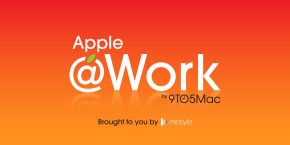
Apple @ Work is brought to you by Jamf, the standard for Apple in the enterprise. Learn more at Jamf.com/9to5mac.
Over the past few weeks, I have been looking at how forward-thinking Apple-focused organizations should be moving their overall operations to “the cloud” or software-as-a-service solutions. In previous weeks, we looked at email, web hosting, network security, and more. This week, I am going to look at how cloud networking has revolutionized how IT departments should be managing their core infrastructure. I will also discuss cloud networking, device management, and endpoint security.
About Apple @ Work: Bradley Chambers has been managing an enterprise IT network since 2009. Through his experience deploying and managing firewalls, switches, a mobile device management system, enterprise-grade Wi-Fi, 100s of Macs, and 100s of iPads, Bradley will highlight ways in which Apple IT managers deploy Apple devices, build networks to support them, train users, stories from the trenches of IT management, and ways Apple could improve its products for IT departments.
Cloud Networking
I’ve been using cloud networking since 2012, and I can’t imagine going back. Managing multiple campuses has been a breeze because they are all operating under a single network policy. Rather than having to manage your switches and access points from individual web interfaces, cloud networking allows you to do it all from a single interface from anywhere. Extreme Networks is a fantastic vendor for cloud networking. They have an edge to the data center approach, which means you can manage your entire network from a single cloud-hosted interface. Deploying one access point and a small switch is as easy as 500 APs and 30 switches. Extreme is also the official networking provider of the NFL. Their support is also fantastic as they don’t outsource it to a third-party company. They were also one of the first companies to offer Wi-Fi 6 access points.
If you need a low-cost solution, you might want to check out Ubiquiti. They offer low-cost enterprise networking products that perform very well. They don’t offer phone support, so you’ll be relying on chat and forum-based support.
Their cloud key allows you to easily manage your network from offsite without having to set up a bunch of port forwarding, but I actually like a company called HostiFi for UnFi hosting. For $50/per month, you can manage up to 500 devices (access points, switches, security gateways, etc.). I am a big fan of their new Dream Machine lineup, but it cannot be managed by a third-party hosting company. Overall, the products are easy to set up, low cost, but just keep in mind that you won’t be able to call someone if you need support.
Both of these products have their advantages, but the key thing for me is that you have a plan for scalability as your employees continue to bring in more Apple devices into your network. Cloud networking is the only way you will be able to scale up.
Device Management
Device Management for Apple organizations should be cloud hosted. These products have become so complicated, that pretty much all of the leading vendors are moving to SaaS type deployments. As your Apple device lineup grows, there is no reason to host these products in your own data center. Especially for iOS devices, you will see a lot of mobile connectivity. When it comes to achieving zero-touch deployment, a cloud-hosted MDM will allow you to have a turn-key approach so you can spend your time getting devices into the hands of end users instead of spending time configuring the software to manage the devices.
Endpoint security
Endpoint security is something that a lot of Apple-focused organizations likely haven’t considered yet, but they should. Macs are incredibly secure products, and the majority of issues that I see with malware are things the user installed. But there are some very polished endpoint security products for macOS that organizations should consider with their Apple deployments. When considering endpoint security, be sure to find one that uses native API access with a kextless agent. These products can change very quickly, and you will want to keep up to date with the latest threats. By using a SaaS product, you’ll know that your employees that aren’t behind your firewall are protected. As employees become more mobile, protecting the individual device is going to be essential. You won’t be able to rely on the firewall alone.
Wrap-up on Cloud networking, Endpoint security, etc.
Over the past few weeks, we’ve looked at various parts of an organization that you should consider using a SaaS provider when deploying. I didn’t cover all possible aspects, but my rule of thumb for anything we implement in 2020 is that I want a turnkey solution that I don’t have to host and manage myself. Is your organization using cloud services? Let’s discuss the pros and cons in the comments.
Thanks to Jamf for sponsoring Apple @ Work. As the standard for Apple in the enterprise, Jamf is committed to enabling IT to bring the legendary Apple experience to businesses, education institutions and government organizations via its product portfolio built-exclusively for Apple. Jamf currently has over 35,000 customers in over 100 countries using Jamf Pro, Jamf Now, Jamf Connect, Jamf Protect, and Jamf School for managing iPhones, iPads, Macs, and Apple TVs.
Learn more at Jamf.com/9to5mac.
Photo by Sergey Zolkin on Unsplash
FTC: We use income earning auto affiliate links. More.






Comments